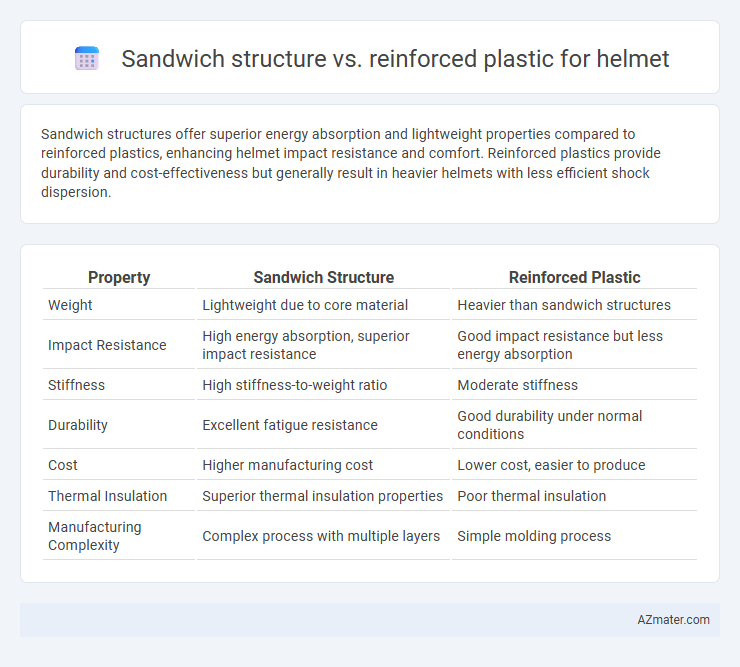Sandwich structures offer superior energy absorption and lightweight properties compared to reinforced plastics, enhancing helmet impact resistance and comfort. Reinforced plastics provide durability and cost-effectiveness but generally result in heavier helmets with less efficient shock dispersion.
Table of Comparison
| Property | Sandwich Structure | Reinforced Plastic |
|---|---|---|
| Weight | Lightweight due to core material | Heavier than sandwich structures |
| Impact Resistance | High energy absorption, superior impact resistance | Good impact resistance but less energy absorption |
| Stiffness | High stiffness-to-weight ratio | Moderate stiffness |
| Durability | Excellent fatigue resistance | Good durability under normal conditions |
| Cost | Higher manufacturing cost | Lower cost, easier to produce |
| Thermal Insulation | Superior thermal insulation properties | Poor thermal insulation |
| Manufacturing Complexity | Complex process with multiple layers | Simple molding process |
Introduction to Helmet Materials
Sandwich structures in helmets feature multiple layers, typically combining a lightweight core material like foam or honeycomb with strong outer skins, providing enhanced impact absorption and stiffness. Reinforced plastics, often made from fiberglass or carbon fiber composites embedded in a polymer matrix, offer high strength-to-weight ratios and excellent durability. Choosing between sandwich structures and reinforced plastics depends on factors like weight, impact resistance, and manufacturing complexity in helmet design.
Overview of Sandwich Structure Technology
Sandwich structure technology in helmets involves a lightweight core material, such as foam or honeycomb, encapsulated between two rigid face sheets, enhancing impact absorption and structural integrity. This design offers superior energy dissipation and improved stiffness-to-weight ratio compared to traditional reinforced plastics made from fiberglass or carbon fiber composites. The core's unique geometry in sandwich structures significantly reduces overall helmet weight while maintaining high safety standards, making it a preferred choice in advanced protective gear manufacturing.
Fundamentals of Reinforced Plastic Helmets
Reinforced plastic helmets utilize fiber reinforcements such as glass, carbon, or aramid embedded in a polymer matrix to enhance impact resistance and structural integrity. Unlike sandwich structures, which combine multiple layers for stiffness and lightweight properties, reinforced plastics rely on the mechanical synergy between fibers and resin to absorb shock energy efficiently. The fundamental strength of reinforced plastic helmets comes from fiber orientation, resin type, and manufacturing process, enabling superior durability and energy dissipation during impacts.
Comparative Material Properties
Sandwich structures in helmets offer superior impact energy absorption due to their layered design combining lightweight core materials like foam with strong outer skins, resulting in enhanced stiffness-to-weight ratios compared to reinforced plastics. Reinforced plastics, typically composed of polymer matrices embedded with fibers such as fiberglass or carbon fiber, provide excellent tensile strength and durability but often have higher weight and less efficient energy dispersion than sandwich constructions. The choice between these materials depends on balancing helmet performance factors like weight, impact resistance, and manufacturing cost, with sandwich structures generally favored for advanced protection and ergonomic comfort.
Weight and Comfort Considerations
Sandwich structures in helmets utilize lightweight composite cores between thin outer layers, significantly reducing weight while maintaining strong impact resistance, enhancing wearer comfort during extended use. Reinforced plastics, although durable and cost-effective, tend to be heavier and less flexible, potentially causing discomfort and fatigue over prolonged periods. Optimizing helmet design with sandwich structures improves breathability and weight distribution, making them superior for both comfort and performance compared to traditional reinforced plastic helmets.
Impact Resistance and Energy Absorption
Sandwich structures in helmets offer superior impact resistance due to their layered configuration, combining a stiff outer shell with a lightweight core that effectively distributes and dissipates energy upon impact. Reinforced plastics, while durable, tend to absorb less impact energy because their homogeneous composition lacks the specialized internal architecture for optimal energy dispersion. Consequently, sandwich structures provide enhanced energy absorption and better protection against blunt force trauma compared to traditional reinforced plastic helmets.
Durability and Lifespan
Sandwich structures in helmets offer superior durability due to their multi-layer design combining rigid outer shells with energy-absorbing core materials, enhancing impact resistance and lifespan compared to conventional reinforced plastics. Reinforced plastics, while strong and lightweight, tend to exhibit reduced fatigue resistance and may degrade faster under repeated stress and environmental exposure. The composite layering in sandwich helmets significantly extends service life by mitigating crack propagation and maintaining structural integrity over prolonged use.
Cost-Efficiency and Manufacturing
Sandwich structures offer superior impact resistance and energy absorption for helmets but involve higher material and fabrication costs due to complex layering and curing processes. Reinforced plastics, such as fiberglass or carbon fiber composites, provide a more cost-efficient manufacturing route with faster production cycles and lower tooling expenses, making them suitable for mass-market helmets. Manufacturing choice depends on balancing budget constraints with performance requirements, where reinforced plastics optimize cost-efficiency while sandwich structures enhance safety.
Safety Standards and Certifications
Sandwich structures in helmets typically consist of a lightweight core material like foam or honeycomb, combined with strong outer layers, offering superior impact absorption and compliance with rigorous safety standards such as DOT, ECE, and Snell certifications. Reinforced plastic helmets, often made from fiberglass or polycarbonate composites, provide durability and resistance to penetration but may offer less energy dissipation compared to sandwich composites under high-impact conditions. Choosing between these materials depends on meeting specific certification criteria that test impact attenuation, penetration resistance, and retention system effectiveness to ensure maximum wearer protection.
Future Trends in Helmet Material Innovation
Future trends in helmet material innovation emphasize lightweight sandwich structures combining foam cores with composite outer layers to enhance impact absorption and energy dispersion. Reinforced plastics, such as carbon fiber or glass fiber composites, continue evolving with nanomaterial integrations to boost mechanical strength and durability while reducing weight. Advancements in bio-based resins and smart materials aim to improve sustainability and real-time damage detection in helmet manufacturing.

Infographic: Sandwich structure vs Reinforced plastic for Helmet
 azmater.com
azmater.com